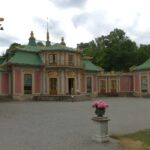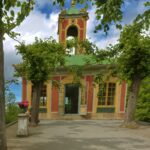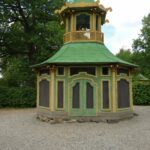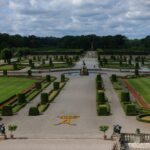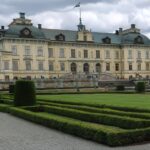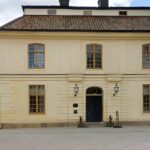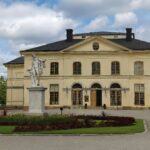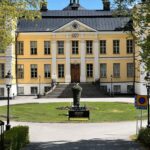Visit the royal palaces and country manor houses where the early Bernadotte court lived and loved.
Click on the locations on the map, or view a full list of the locations further down the page.
St. Jacob’s Church
Just across the King’s Garden from Jacquette’s home in Stockholm, St. Jacob’s Church dates back to the 1300s, when a wooden chapel was built on this site. Today it is painted in red tones, its historic color, but in Jacquette’s time its exterior was white. The church sits on the edge of the park, and its cemetery is filled with ancient burial monuments. The last burial in the churchyard took place in 1808.
Read morePasch's Stone House, Bellevue
Across Brunnsviken from Haga Pavilion lies Bellevue, perched atop a hilly section of the lakeshore. In 1813 when Crown Prince Charles Jean left to lead the Army of the North against Napoleon in the War of the Sixth Coalition, elderly, childless King Charles XIII and Queen Hedvig Elisabeth Charlotta were left to supervise teenage Prince Oscar. Their palace at Rosersberg was being renovated, so they moved to Haga, where they allowed Oscar to set up his household across the lake at Bellevue, where there was a substantial compound. The older house had been built by Johan Pasch in 1757. There was also a larger house built by Carl Sparre in 1783, and accessory buildings, including stables.
Read moreHaga Pavilion
Haga Pavilion is located in Haga Park, only about three miles from Stockholm. The small palace was built by Gustav III in the late 1700s to be his private residence at the royal domain. In the early 1800s, Queen Hedvig Elisabeth Charlotta, Queen Charlotte in Butterfly Games, often stayed at Haga Pavilion. The pavilion’s famous “wall of windows” looks onto Brunnsviken’s shore, and was viewed as an architectural marvel when constructed.
Read moreArsenal Theater
The Royal Dramatic Theater, which was owned and managed by the Crown, held its performances at the so-called Arsenal Theater between 1793 and 1825. During that period, the theater was housed in the former Makalös Palace, the former mansion of the powerful de la Gardie family, which had served as an arsenal from 1693 to 1793. The imposing structure was located in central Stockholm at the south end of Kungsträdgården (the King’s Garden) on the shore of Lake Mälaren. Kungliga Slottet (Stockholm Palace) is directly across the lake, a short distance away. On November 24, 1825, the Royal Dramatic Theater was performing August von Kotzebue’s play, The Victory of Honor Over Disgrace. At the end of the fourth act, one of Sweden’s foremost actors, Lars Hjortsberg, calmly announced that fire had been detected and told the audience to depart. The theater held 600 people and had only a single narrow exit. The spectators escaped but tragically, several employees were killed. The so-called “crown wind” spread the fire, and all four towers and the roof ignited simultaneously. Within a few hours, the theater burned to the ground, signaling the end of an era and an enormous cultural loss for the city. King Charles Jean and Crown Prince Oscar rushed to the scene and Charles Jean is credited with creating order from the chaos during a long, cold night. The Wetterstedts had a box at the Arsenal Theater, and Jacquette attended performances frequently.
Read moreFrench Inn
The French Inn, located on the former royal hunting ground called Djurgården, opened in the late 18th century. King Charles XIV Jean was known to dine here and was said to enjoy the French owner/chef's cuisine and the casual surroundings.
Read moreKing's Garden
As early as 1430, this small city park served as the king's vegetable garden. It borders Stockholm's fashionable Blasieholmen district and today is a center of urban life. Once surrounded by walls and accessible only to royal and aristocratic visitors, it was opened to the public in the late 1700s. In the early 1800s, Crown Prince Charles Jean had the greenery removed, replacing it with gravel so the space could be used for military exercises. In 1822, he renamed the park, calling it Carl XIII Square and unveiled a statute to honor his predecessor. Carl XIII, a frail and childless king, adopted the 50-year old French general Jean-Baptiste Bernadotte, who then called himself Charles Jean, thus founding the Bernadotte dynasty.
Read moreDouglas House
Douglas House (Douglaska Palatset, built in 1654) was Jacquette’s principal home between ages 14 and 20. Court Chancellor Wetterstedt leased these fine apartments (probably on the upper floors) shortly before he married Jacquette’s mother, Aurora De Geer, in November 1811. Located on Blasieholm Square across from the Fersen Palace, just a few doors away from the Foreign Ministers’ Residence, Douglas House enjoys one of the best locations in Stockholm. The building’s facade was altered in 1874, but one can stand in Blasieholm Square and look up, imagining Jacquette sitting in her favorite window seat and gazing past the Fersen Palace and Lake Mälaren to Stockholm Palace, where Prince Oscar lived only a short distance away. The Wetterstedts lived at Douglas House until 1823, when Gustaf af Wetterstedt was appointed foreign minister and the household moved down the street to the Foreign Ministers’ Residence (Utrikesministerhotellet). The celebrated courtier and artist Fritz von Dardel, whose drawings of Stockholm society and court life are uniquely of value in understanding this period, lived at Douglas House beginning in the 1870s. His drawings included portraits of Jacquette’s brother Nils and Carl Löwenhielm, both characters in Butterfly Games.
Read moreThe House of Nobility
The House of the Nobility (Riddarhuset) is owned by the Swedish nobility and was built between 1641 and 1672. The organization maintains genealogical records tracing the lineage of each noble family. One of Stockholm’s architectural treasures, the palace was designed by Simon de la Vallée, Heinrich Wilhelm, Joost Vingboons, and Jean de la Vallée.
Shields of the 2,326 noble families are displayed on the walls of its Great Hall, where sessions of the Noble Estate were held when the Swedish diet was organized into four Estates (Nobles, Merchants, Clergy, and Peasants) from 1668-1865. At the time, the Speaker of the Noble Estate was one of the most powerful participants in the diet, or Riksdag. Jacquette’s stepfather, Gustaf af Wetterstedt, represented the crown at numerous diets during the reign of Charles XIV Jean, and these sessions had an impact on her life and activities, as the royal family and nobility remained in Stockholm until the diet concluded.
Read morePublic Orphanage
Stockholm's Public Orphanage, or "Allmänna Barnhus" stood for 250 years at the corner of Barnhusgatan and Drottninggatan. It was built in 1637. After the institution moved to another location in 1885, the building was destroyed in 1886. Children worked to pay for their food and clothing by, among other things, manufacturing rope for the military. Beginning in 1785, when two institutions, Stora Barnhus and Politibarnhus merged to form Allmänna Barnhus, admittance fees were imposed on mothers who brought their children to the orphanage, and the orphanage began to place children in foster homes. It also opened to children from infancy to 14 years old. In 1825, 52% of children brought to the orphanage died within the first year. [Historisk statistik för Sverige, del 1 (1720-1967), Stockholm 1969, p. 115]
Read moreRosendal Palace
While still crown prince, Charles Jean bought this property on the north shore of the large city park called Djurgården, the former Royal Hunting Ground, in 1817 from his aide Louis Camps, who had fallen into debt. The original house burned in 1819, and Charles Jean began construction of a new pleasure palace, which was not completed until 1827. In the interim, the Queen's Pavilion was built quickly and used for entertainment. Rosendal was the site of regular Sunday dinners and parties in the warm season, and was built without bedrooms.
Read moreBellevue
The estate, on the southern shore of Brunnsviken across from Haga Palace, houses two manor houses, the simpler "Pasch's Stone House" (1755) and the larger wooden building "Sparre's Timber Palace," built in the 1780s. Sparre left the property to King Carl XIII, and Oscar I was given use of the compound as early as 1816. It included gazebos, lake overlooks, and an alley of linden trees. Johan Pasch, who built the single story farmhouse, is famous as the court artist who painted the beautiful ceilings in Stockholm Palace's chapel and the court theater at Drottningholm.
Read moreStock Exchange
Today the site of the Nobel Museum, the Stock Exchange was used for balls in the early 1800s, particularly on New Year's Eve. The ballroom, on the second floor, was hot and crowded. A wide cross-section of society attended, from workers to the royal family.
Read moreOrphanage Windmills
Two windmills stood at the site of the current Tegnérlunden Park in Norrmalm. In ruins, they were demolished in 1890 when the park was laid out.
Read moreChina Palace
The China Palace, or Kina Slott in Swedish, was built as a pleasure palace for entertainment. Preserved as it was furnished in the 18th century, it is a highlight of the UNESCO World Heritage Site and a principal reason for Drottningholm's inclusion. The pavilion has no bedrooms, and it is said that Oscar I is the only king who ever spent a night at the China Palace.
Read moreConfidencen
This single-room structure, furnished as a dining room, was built in the 18th century. Its large dining table could be lowered into its two-level basement to permit staff to serve dinner without entering the room, where the king would dine "in confidence" with his companion.
Read moreAviaries
In the 1700s, a pair of Aviaries housed a collection of exotic birds and guests visiting the China Palace could stroll and enjoy their beauty and song.
Read moreDrottningholm Palace Park
The older of the two grand parks at Drottningholm Palace, the Baroque Garden features fountains and a maze.
Read moreDrottningholm
Sweden's Versailles, only better. Drottningholm, which means "Queen's Island," was built in the 1660s on an island in Lake Malaren about seven miles from Stockholm. Today, the King and Queen make their home here, and no trip to Sweden would be complete without a visit.
Read moreChurch Pavilion
One of four similar buildings that line the Theater Courtyard between Drottningholm Palace and the Court Theatre, the Church Pavilion, located on the east side of the walk, was built in the late 1700s and was often used as a summer residence for ladies in waiting.
Read moreDrottningholm Palace Theater
Built in 1766, its working theater machinery is among the world's best-preserved. The theater interior, once filled with surplus furniture, was rediscovered in the 1920s. Today, numerous productions are staged in this beautiful setting.
Read moreFinspång Castle
Built in 1666 by Louis De Geer, this Netherlandish manor house was owned by Jacquette's family for almost 200 years. She lived here with her maternal aunt, Emilie De Geer, from the age of six until she was about fourteen. Jacquette always considered Finspång, home of the famous De Geer cannon foundry, her favorite place on earth. The castle was sold by her brothers and today is owned by Siemens, the German corporation. The lush park is open to the public, but the castle cannot be accessed for visits absent an invitation.
Read moreFull list of locations
Click on a location name to find out more about each one.
- Arsenal Theater, Stockholm
- Aviaries, Drottningholm
- Bellevue, Haga
- Blasieholm Square, Stockholm
- Children’s Home Windmills, Stockholm
- Children’s Home, Stockholm
- China Pavilion, Drottningholm
- Church Pavilion, Drottningholm
- Confidencen, Drottningholm
- Douglas House, Stockholm
- Drottningholm Palace
- Drottningholm Palace Park
- Drottningholm Palace Theater
- Finspång Castle
- Foreign Ministers’ Residence, Stockholm
- French Inn, Djurgården, Stockholm
- Haga Pavilion
- House of Nobility, Stockholm
- King’s Garden, Stockholm
- Noah’s Ark, Haga
- Pasch’s Stone House, Bellevue
- Rosendal Palace, Djurgården, Stockholm
- St. Jacob’s Church
- Stock Exchange, Stockholm

